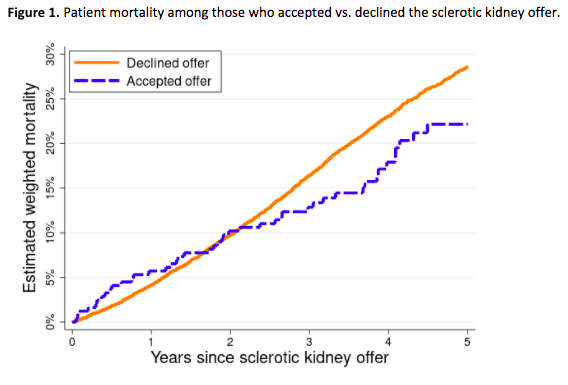Transplant candidate outcomes after accepting sclerotic kidneys in the United States, 2015-2018
Laura Zeiser1, Dorry L Segev2, Allan B Massie2.
1Department of Surgery, Johns Hopkins School of Medicine, Baltimore, MD, United States; 2Department of Surgery, NYU Langone School of Medicine, New York, NY, United States
Introduction: Waitlist candidates who accept the offer of a sclerotic kidney are faced with increased risk of delayed graft function and graft loss, but candidates who decline must wait for a future offer that could involve additional risks or may never materialize. To investigate the potential benefits of accepting a sclerotic kidney, we compared patient mortality between recipients of sclerotic kidneys and waitlist candidates who declined offers of the same kidneys.
Methods: Using national registry data from the United States (SRTR), we identified all offers from deceased donors with at least 20% glomerulosclerosis of both kidneys, 2015-2018. We compared demographic and clinical characteristics of sclerotic kidney recipients to waitlist candidates who declined the offers. Patients were followed from the time of offer until death or administrative censoring on March 31, 2021. An odds-weighted Cox proportional hazards mode including candidate age, sex, race, education, insurance type, BMI, primary diagnosis, time on dialysis, calculated panel reactive antibody (cPRA), ABO type, previous malignancy, previous transplant, serum albumin, and peripheral vascular disease was used to compare mortality between the two groups.
Results: 28,463 offers of sclerotic kidneys were made to 17,467 patients, among whom 245 accepted and received a sclerotic kidney. 207 candidates accepted the first offer of a sclerotic kidney, while 38 accepted a subsequent offer. Compared to their counterparts, sclerotic kidney recipients were older (p<0.001), less likely to be male (60% vs. 66% , p=0.04) or privately insured (28.7% vs. 41.5%, p<0.001), more likely to belong to blood group B (13.9% vs. 5.1%, p<0.001), have cPRA >80% (14.3% vs. 5.1%, p<0.001), and peripheral vascular disease (16.7% vs. 8.5%, p<0.001) (Table 1). Weighted cumulative incidence of mortality following the offer was 6%, 13%, and 22% among recipients and 4%, 16%, and 27% among comparable patients who declined the offer at 1, 3, and 5 years, respectively (Figure 1). Relative risk of mortality did not vary between those who accepted the sclerotic kidney and those who declined (HR=0.81, 95% CI=0.61-1.08).
Conclusion: Offers of kidneys from donors with >20% sclerosis of both kidneys are rarely accepted. As compared to candidates who decline offers of sclerotic kidneys, those who accept do not appear to receive any survival benefit. However, as organ availability varies widely by geographic region in the U.S., so too may the advantages of accepting or declining these organs. Decisions regarding offers of sclerotic kidneys should be considered carefully in the context of organ availability.



right-click to download
